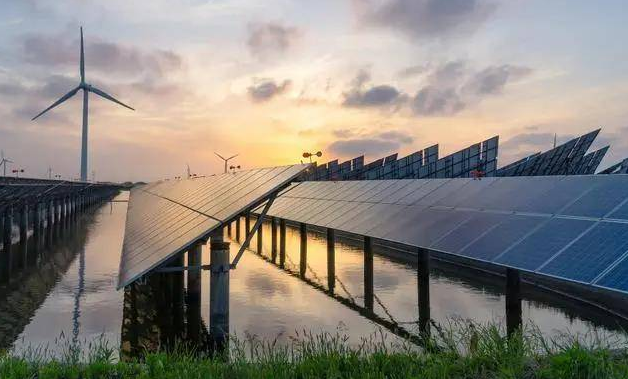On the eve of new energy technology breakthrough, are we ready
Wind, solar, biomass... Which new energy is most favored by the scientific and technological community?
Hydrogen energy will be an important medium to build the future energy system and achieve energy reform, and the breakthrough of solar fuel technology and its cost reduction will rapidly reduce the dependence on fossil fuels
Guo Jianfeng, a researcher at the Strategic Advisory Institute of Science and Technology of the Chinese Academy of Sciences, said that through the analysis of published papers, new energy technologies are in a period of accelerated development, and the number of published documents in seven technical fields, such as solar energy, wind energy and hydrogen energy, in addition to nuclear energy, exceeded 40% of the total in the past 20 years from 2015 to 2019, of which five fields exceeded more than half. Further focusing on the publication situation from 2015 to 2019, it was found that the global attention to new energy continued to rise, and a total of 388,416 papers were published in the field of new energy during the five-year period, with a compound annual growth rate of about 10%.
Guo Jianfeng introduced that the statistics of the top 10 most frequently cited papers can reveal the research directions of different new energy technologies in the world: biomass energy research mainly focuses on lignin pyrolysis, catalysts, pretreatment, microalgae biofuels, biorefining and other directions; Energy storage research mainly focuses on lithium-ion batteries, sodium-ion batteries, lithium-sulfur batteries, positive and negative electrode materials, fast charge technology and other directions; Geothermal energy research focuses on enhanced geothermal systems (EGS), numerical simulation of geothermal systems, and geothermal drilling technology. Research on hydrogen energy mainly focuses on non-precious metal catalysts, metal-organic framework materials, cobalt-based catalysts, bifunctional catalysts, etc. The main concerns of nuclear energy research include nuclear waste disposal technology, nuclear power plant safety technology, radiation resistant materials, magnetic confinement nuclear fusion, inertial confinement nuclear fusion, etc. Solar energy research focuses on perovskite solar cells, laminated solar cells, solar photocatalytic hydrogen production, catalysts, semiconductor electrodes, etc. Energy Internet research focuses on smart energy systems, big data, smart home energy management systems, demand response and other directions; The main focus of wind energy research includes high power energy converter, wind turbine, wind power numerical simulation, wind power high proportion stable grid connection, etc.
In these fields, both paper statistics and scientist interviews have found that hydrogen energy and solar energy are the two new energy sources that we focus on.
In the future energy system, hydrogen energy is an important secondary energy source for carbon reduction, and the research heat of hydrogen production, hydrogen storage, and hydrogen energy transportation and utilization is growing rapidly. Among them, the hydrogen fuel cell or hydrogen engine that has received the first attention can change the traditional means of transportation and solve the problem of urban air pollution and decarbonization caused by transportation fuel consumption. In the process of the rapid increase in the scale of renewable energy power generation, the absorption capacity of the power grid is one of the bottlenecks, and the flexible absorption of wind and light through electrolytic water hydrogen production provides a new path to solve the problem that the scale of photovoltaic and wind power is limited by the consumption side demand and the absorption capacity of the power grid. At the same time, hydrogen production from renewable energy sources will also become a sustainable source of green hydrogen in the future.

Hydrogen energy is an important entry point to promote the deep decarbonization of the energy system. Since 2018, many countries, including Japan, South Korea, Australia, the United Kingdom, and France, have released the latest plans in the field of hydrogen energy. Japan has made it clear that by 2025, it will fully popularize hydrogen transportation, expand the application of hydrogen energy in power generation, industry and households, and by 2030, the cost of hydrogen energy use will be no higher than that of traditional energy. The EU Hydrogen Strategy, published in July 2020, proposes a "strategic roadmap for building a hydrogen ecosystem in Europe to 2050", with the goal of rapidly reducing carbon emissions from hydrogen production and developing other forms of low-carbon hydrocarbon to support the transition to renewable hydrogen production before 2030. China is more active in the research and development of key technologies for hydrogen energy. China's earliest hydrogen energy development deployment is to list hydrogen fuel cell vehicles as one of the development directions of new energy vehicles. However, due to the high cost of hydrogen production technology and hydrogen fuel cells and the layout of hydrogen refueling stations and other problems restricting the development of the industry, compared with pure electric vehicles and hybrid electric vehicles, hydrogen fuel cell vehicles are still in the demonstration operation stage. In response, China's research activity in key links such as hydrogen production, hydrogen storage and hydrogenation also ranks at the forefront of the field of new energy.
The research and development of zero-carbon solar fuel technology is the focus of great attention in the scientific research community. According to the report, solar fuel research is at the forefront of the volume of publications and attention, indicating that humanity continues to pursue the use of sustainable natural resources (water, carbon dioxide) and energy (solar energy), in order to obtain green fuels through more ecological and efficient conversion mechanisms. Scientists have made a lot of efforts in the fields of photolytic water to produce hydrogen and solar fuel, but there is still some distance from application. For example, photocatalytic hydrogen production is still in the laboratory research and development stage, and how to reduce the cost of solar fuel preparation is still the bottleneck of its industrialization.
Industrialization encountered a bottleneck, who is the "obstacle" of new energy application?
The overall technology conversion rate of research results in the global new energy field is low, and the combination of industry, university and research needs to be strengthened; Energy storage technology and energy Internet have attracted global attention
Chen Wei, deputy director of the Strategic Information Center of the Wuhan Literature and Information Center of the Chinese Academy of Sciences and research librarian, concluded that the overall technology conversion rate of research achievements in the global new energy field is low, and the combination of industry, university and research needs to be strengthened. Relatively speaking, the conversion rate of research results of energy storage, biomass energy and solar energy is relatively high, and lithium-ion batteries and organic solar cells are technical hot spots of common concern for industrial transformation at home and abroad.
The results show that the research of energy storage, solar energy and hydrogen energy technology has the highest market attention at home and abroad, and the technologies with relatively high industrial conversion are energy storage, biomass energy and solar energy technology. The new energy technology hotspots of common concern in the world and China are concentrated in the field of battery energy storage and solar photovoltaic, especially lithium-ion batteries and organic solar cells.
Among new energy technologies, the most concerned are energy storage technology and energy Internet.
Energy storage technology is an important component of the construction of modern energy systems, especially the number of papers published in battery energy storage, the growth rate and the comprehensive performance of high-quality research ranked first in the evaluation. Chen Wei introduced that renewable energy power generation, smart grid and distributed multi-energy complementary systems, electric vehicles are the key directions of low-carbon transformation of the power system in various countries, and energy storage technology is an essential technical support to achieve changes in the above areas, and is a soft link key node of the future energy system with flexible, inclusive and balanced functions.
With the wide application of energy storage technology in energy production, consumption and low-carbon smart transformation, it is increasingly urgent to improve the safety, energy density, capacity scale, endurance, service life and reduce battery costs. The paper and patent analysis show that electrode materials, electrolytes and other battery materials are the research hotspots to improve battery performance. Experts in the field believe that lithium iron phosphate batteries and ternary lithium batteries have successively become the main technical direction of power battery material innovation. Battery performance breakthrough routes mainly include energy storage battery system structure innovation, battery pack space utilization optimization, battery energy density and safety improvement, and battery cost reduction.
Energy Internet is the new infrastructure of modern energy system. With the increasing demand for energy and the emergence of the trend of electrification, the future of the world will accelerate the formation of oil, natural gas, coal, renewable energy based diversified energy structure, and in the middle of the 21st century to complete the transition to non-fossil energy based energy structure. Therefore, although the energy technology innovation of energy varieties is still important, the breakthrough of system technology such as the integration combination, fusion matching, intelligent operation and maintenance, supply and demand two-way interaction, and multi-network interaction is also particularly important and urgent. At the same time, the modern energy system inevitably needs the support of cross-border science and technology integration such as big data mining, information flow management, detection and network ubiquity, and decision optimization.

In the scenario of global carbon neutrality, the energy system will have the basic attributes of diversity, wisdom, safety and flexibility, which means that the importance of energy Internet technology, smart energy system technology and other research is highlighted, and the application of basic research and applied technology research and development will continue to receive attention.
According to the analysis of the report, the current energy Internet research still needs to pay attention to the following issues: First, pay attention to the energy Internet architecture and core equipment technology research, and make breakthroughs in the intelligent energy production and consumption, energy Internet system planning, multi-energy flow energy exchange and routing technology, energy intelligent transmission technology, and intelligent network collaborative control technology; Second, pay attention to the technology research of big data collection, mining and utilization of energy systems, and make breakthroughs in energy Internet communication, energy information and information physical integration, energy big data application technology, and energy Internet management technology; The third is to pay attention to the landing transformation of energy Internet technology, and make breakthroughs in the research design, demonstration application, and landing implementation of multi-disciplinary, information network infrastructure and energy infrastructure link.
How does China fare in the New energy R&D race?
The total contribution of China in the field of new energy research is large, and the contribution of high-quality research is also high. However, compared with developed countries, the overall efficiency of research still needs to be improved
Tan Xianchun, deputy director and researcher of the Institute of Sustainable Development Strategy of the Strategic Advisory Institute of Science and Technology of the Chinese Academy of Sciences, introduced that the report compared the main contributions of the leading countries in new energy research to the development of the field and found that there are differences in research efficiency among countries. China's number of published documents in the eight new energy technology fields ranked first and second in the world, indicating that it has a strong degree of activity in the main directions of new energy research. A comprehensive analysis of the research influence of eight technical fields (citation frequency and number of high-quality research papers) shows that the number of high-quality papers in China ranks top six in all technical fields, but the citation frequency of papers in most fields ranks relatively low, indicating that China's research efficiency in the field of new energy technology still needs to be further improved.
For example, in the country comparison, the number of published papers in the field of energy Internet in China is the largest, and the number of high-quality papers is also in the lead, indicating that the Chinese scientific research community pays great attention to the theoretical frontier research of energy Internet, and has certain competitiveness in the field of energy Internet research. However, from the ranking of countries with the frequency of citations, China only ranks fifth in the world, indicating that there is still a certain gap between the influence of Chinese papers and that of the United Kingdom and the United States, and it is still necessary to strengthen the research of key core technologies and improve the research level in the field of energy Internet.
But China also shines in a number of areas. Tan Xianchun said, for example, China's energy storage industry has rapidly become a global up-and-comer. In particular, the report mentions that the "Energy Storage Industry Research White Paper 2020" jointly released by the Energy Storage Committee of the China Energy Research Society shows that the cumulative installed capacity of global battery energy storage in 2019 is 9520.5MW, of which the cumulative installed capacity of lithium-ion battery energy storage accounts for 88.6%. Although China's energy storage industry started late, but in recent years, the development speed is remarkable, the cumulative installed capacity of battery energy storage has reached 1709.6MW, of which the cumulative installed capacity of lithium-ion battery energy storage accounted for 60%, in 2015-2019, the cumulative installed capacity of lithium battery energy storage increased by more than 100% per year.
The report puts forward recommendations for the development of new energy in China:
First, the breakthrough and popularization of large-scale energy storage technology is a strong support for the development of renewable energy. The rapid rise of renewable energy such as wind and solar energy and the smart grid industry has made energy storage technology an urgent technical barrier for countries around the world to overcome. Large-scale and efficient energy storage technology is the key technology to achieve the popularization of renewable energy, which can solve the difference between power generation and electricity consumption and the impact of intermittent renewable energy generation directly connected to the grid, and is a soft link key node with flexible, inclusive and balanced functions in the future energy system. China should further improve the policy mechanism to promote the development of energy storage industry, guide long-term capital investment through financial and market-oriented means, build energy storage scientific and technological innovation and technology reserve system, strengthen new energy and energy storage integrated application research, and promote large-scale energy storage technology breakthroughs and commercial applications.

Second, hydrogen energy will become an important medium for building the future energy system and achieving energy reform. With the low-carbon and non-carbonized transformation of human society, the breakthrough and utilization of hydrogen energy technology has become an important direction of energy clean development. Many countries and regions in the world have issued a strategic roadmap for hydrogen energy development, elevating hydrogen energy planning to a national strategic level. As an important energy medium for interconnection and complementarity of various energy networks and collaborative optimization, hydrogen energy can improve the utilization rate of renewable energy, realize the coupling of power grid and gas network, and increase the flexibility of power system. At the same time, it has the energy storage function, and realizes energy consumption and storage by electrolyzing water to produce hydrogen from renewable energy. Therefore, it is necessary to strengthen the top-level design of hydrogen energy, clarify the large-scale application scenarios, rationally propose the hydrogen energy development roadmap under different scenarios, and formulate corresponding standards and specifications, and accelerate the development of the industrial chain such as green hydrogen production, storage, transportation and application.
Third, solar fuel technology breakthroughs and cost reductions will help reduce oil dependence. Solar fuel technology is gradually developing from basic scientific research to industrial viable technology, which is expected to fundamentally change the over-reliance on fossil resources in the energy and chemical industries. The progress of solar power generation technology and wind power generation technology will further reduce the cost of power generation, and drive the renewable energy electrolytic water hydrogen production quickly to become a green and sustainable solar fuel production route. The key to using solar energy to efficiently convert water and carbon dioxide into fuels or chemicals is how to reduce costs and improve efficiency. China should continue to increase the research and development of solar fuel technology, strengthen the research and development and application of solar power technology and building and other infrastructure integration technology, select areas rich in sunlight resources to carry out typical demonstration projects, and promote the industrial production process of solar energy technology.
Fourth, the energy Internet will give play to the dual advantages of "Internet plus" and smart energy to achieve overall and optimized energy allocation. The energy Internet can realize the reconstruction of energy production and consumption order, deeply integrate energy production, transmission, storage, consumption and market operation with information and communication technology, create new business models, and realize a new energy ecosystem of energy sharing. The construction of the energy Internet needs to strengthen the integration of mobile Internet, cloud computing, big data and the Internet of Things and other technologies in the smart grid, build a financial support platform, strengthen the management system for the construction of shared energy infrastructure, realize the marketization of the energy Internet, and build a safe, efficient and sustainable smart energy system. China should actively promote the research and development of key technologies of the energy Internet, strengthen the interconnection between different energy networks, promote the construction of comprehensive energy network infrastructure, and improve the service and management and operation mechanism of the energy Internet.
- EMERSON
- Honeywell
- CTI
- Rolls-Royce
- General Electric
- Woodward
- Yaskawa
- xYCOM
- Motorola
- Siemens
- Rockwell
- ABB
- B&R
- HIMA
- Construction site
- electricity
- Automobile market
- PLC
- DCS
- Motor drivers
- VSD
- Implications
- cement
- CO2
- CEM
- methane
- Artificial intelligence
- Titanic
- Solar energy
- Hydrogen fuel cell
- Hydrogen and fuel cells
- Hydrogen and oxygen fuel cells
- tyre
- Chemical fiber
- dynamo
- corpuscle
- Pulp and paper
- printing
- fossil
- FANUC
- Food and beverage
- Life science
- Sewage treatment
- Personal care
- electricity
- boats
- infrastructure
- Automobile industry
- metallurgy
- Nuclear power generation
- Geothermal power generation
- Water and wastewater
- Infrastructure construction
- Mine hazard
- steel
- papermaking
- Natural gas industry
- Infrastructure construction
- Power and energy
- Rubber and plastic
- Renewable energy
- pharmacy
- mining
- Plastic industry
- Schneider
- Kongsberg
- NI
- Wind energy
- International petroleum
- International new energy network
- gas
- WATLOW
- ProSoft
- SEW
- wind
- ADVANCED
- Reliance
- YOKOGAWA
- TRICONEX
- FOXBORO
- METSO
- MAN
- Advantest
- ADVANCED
- ALSTOM
- Control Wave
- AB
- AMAT
- STUDER
- KONGSBERG
- MOTOROLA
- DANAHER MOTION
- Bentley
- Galil
- EATON
- MOLEX
- Triconex
- DEIF
- B&W


email:1583694102@qq.com
wang@kongjiangauto.com

















































